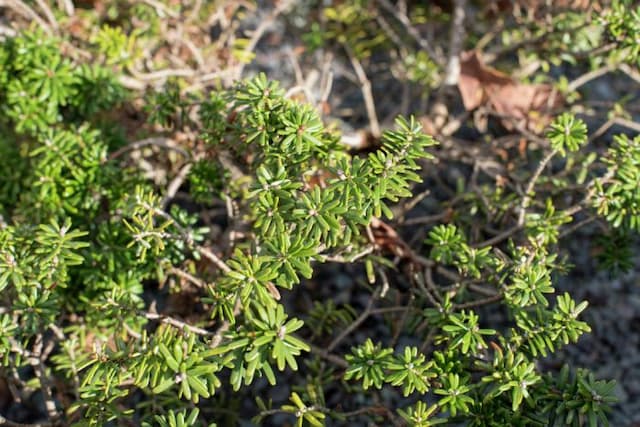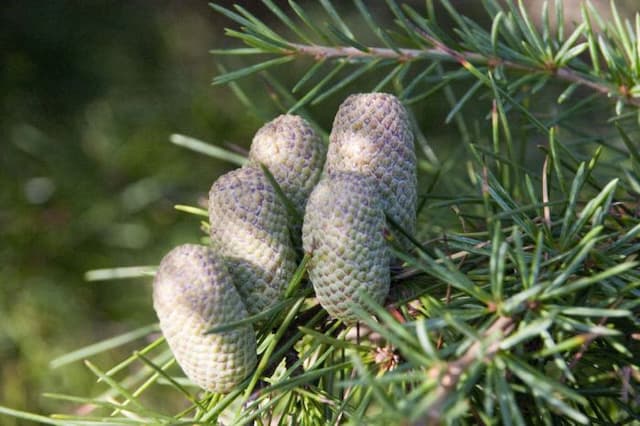Atlas Cedar Cedrus atlantica

ABOUT
The plant commonly known as the Atlas Cedar has a majestic appearance, characterized by its dense, pyramidal shape that can become more openly conical with age. The needles on this conifer are a stunning bluish-green to silvery-blue, adding a striking color to the landscape. These needles can be quite stiff and are typically arrayed in clusters on short side stems, giving the branches a somewhat tufted look. As a feature that makes this plant distinct, the bark is grayish with a rough texture, becoming deeply fissured with age. The cones, which develop on mature trees, are barrel-shaped, up to 6 inches long, and sit upright on the branches. They start off as green but mature to a brown color, standing out against the foliage. Overall, the Atlas Cedar presents a grandiose and elegant silhouette with its layered branches and eye-catching needle coloration, making it a favorite in many landscapes for its ornamental appeal.
About this plant
 Names
NamesFamily
Pinaceae
Synonyms
Atlas Cedar, Cedar of Lebanon, Moroccan Cedar
Common names
Cedrus libani subsp. atlantica, Cedrus libani var. atlantica.
 Toxicity
ToxicityTo humans
The Atlas cedar (Cedrus atlantica) is generally not considered toxic to humans. There is little evidence to suggest that handling or ingesting parts of this plant would lead to poisoning. However, as with many plants, individual allergies or sensitivities can occur, and it is always advisable to exercise caution and avoid ingesting plant material that is not meant for consumption.
To pets
Similarly to humans, the Atlas cedar is not known to be toxic to pets. It is not commonly reported to cause poisoning in animals such as dogs and cats. However, ingestion of non-food items, including parts of this plant, can potentially lead to gastrointestinal upset or obstruction in pets, so it's wise to prevent pets from consuming plant material.
 Characteristics
CharacteristicsLife cycle
Perennials
Foliage type
Evergreen
Color of leaves
Blue-green
Height
40-60 feet (12-18 meters)
Spread
30-40 feet (9-12 meters)
Plant type
Tree
Hardiness zones
6-9
Native area
Atlas Mountains
Benefits
 General Benefits
General Benefits- Aesthetic Appeal: Cedrus atlantica, commonly known as the Atlas cedar, is valued for its majestic appearance and is widely used in landscaping for ornamental purposes.
- Durability: The wood of the Atlas cedar is known for its durability, making it suitable for construction and woodworking.
- Shade Provision: With its broad canopy, the Atlas cedar provides ample shade in gardens and parks, making it ideal for creating comfortable outdoor spaces.
- Erosion Control: This plant can help prevent soil erosion when planted on slopes due to its root system that stabilizes the ground.
- Habitat for Wildlife: Atlas cedar trees offer habitat to various species of birds and insects, supporting biodiversity.
- Windbreak: When planted in rows, Atlas cedars can act as effective windbreaks, protecting other plants and reducing wind erosion.
- Fragrance: The wood and needles of the Atlas cedar emit a pleasant, woody scent that can be enjoyable in garden settings.
 Medical Properties
Medical Properties- Antimicrobial: Cedarwood oil, derived from Cedrus atlantica, has been known to possess antimicrobial properties that may help in reducing and inhibiting the growth of certain types of bacteria and fungi.
- Anti-inflammatory: Components found in the essential oil of the Atlas cedar tree may exhibit anti-inflammatory effects that can be beneficial in treating conditions associated with inflammation.
- Antispasmodic: The essential oil is said to help relax muscle spasms when used in aromatherapy or as a topical agent.
- Diuretic: Traditionally, Cedrus atlantica essential oil has been used to increase urine production which can assist in detoxification and cleansing of the body systems.
- Expectorant: Cedarwood oil is believed to help in the relief of congestion and in the expulsion of phlegm from the respiratory system.
- Sedative: The calming effect of cedarwood essential oil is often exploited in aromatherapy to alleviate stress and improve sleep quality.
 Air-purifying Qualities
Air-purifying QualitiesThis plant is not specifically known for air purifying qualities.
 Other Uses
Other Uses- Cedrus atlantica wood shavings are often used in the creation of cedar sachets which are placed in drawers and closets to impart a pleasant aroma and deter moths.
- The resin from the Atlas cedar tree is used in traditional varnishes and can provide a rich finish to wooden furniture and instruments.
- The essential oil derived from this tree is incorporated into perfumes and scented products for its woody and slightly sweet fragrance which lasts long on the skin or in the environment.
- Woodworkers appreciate the fine grain and durability of Cedrus atlantica lumber for crafting musical instruments such as guitars and violins.
- In landscape design, Atlas cedar serves as an excellent windbreak tree due to its dense growth, protecting smaller plants and reducing soil erosion.
- Fine sawdust from the tree can be utilized as a natural component in some composting toilets, aiding in odor control and waste decomposition.
- The tree's thick bark can be processed and used as a natural mulch, providing garden beds with a protective layer that conserves soil moisture and deters weeds.
- The Atlas cedar's large, sturdy branches are sometimes repurposed as rustic outdoor furniture or garden structures after the tree has been felled or pruned.
- Cedrus atlantica cones can be collected and used as biofuel to produce heat or start fires in an outdoor setting, such as campfires or fire pits.
- The dense nature of Atlas cedar wood makes it suitable for carving intricate items like decorative panels, ornaments, or sculptures.
Interesting Facts
 Feng Shui
Feng ShuiThe Atlas Cedar is not used in Feng Shui practice.
 Zodiac Sign Compitability
Zodiac Sign CompitabilityThe Atlas Cedar is not used in astrology practice.
 Plant Symbolism
Plant Symbolism- Strength and Resilience: The Atlas cedar is known for its strong wood and ability to withstand tough conditions, symbolizing robustness and the ability to endure challenges.
- Eternity and Immortality: With its long lifespan and evergreen nature, the Atlas cedar is often seen as a symbol of eternal life.
- Purity and Protection: In various cultures, cedar trees are associated with purification and believed to ward off evil spirits, representing safety and sanctity.
- Peace and Tranquility: The cedar tree's majestic presence and soothing scent are thought to promote peace and calm.
- Spiritual Growth: They are sometimes associated with spiritual growth due to their towering height, pointing upwards towards the heavens.
- Wisdom: In some traditions, the cedar tree is a symbol of wisdom, as its long life and size suggest the accumulation of knowledge over time.
 Water
WaterThe Atlas Cedar should be watered thoroughly but infrequently, allowing the topsoil to dry out between waterings. Generally, young trees require watering once a week, providing about ten gallons per watering to ensure moisture reaches deep roots. Mature trees are more drought-resistant and may need additional water only during prolonged dry spells, roughly once a month with twenty gallons. Adjust watering frequency with seasonal changes, reducing in the cooler, wet months, and increasing in hot, dry periods.
 Light
LightAtlas Cedar thrives in full sun, meaning it requires at least six hours of direct sunlight daily. It's best positioned in a spot in the garden or landscape where it can receive unfiltered sunlight throughout the day. Avoid planting it in shaded areas, as insufficient light can hinder its growth and health.
 Temperature
TemperatureAtlas Cedar is adapted to a wide range of temperatures, but it prefers a temperate climate. It can tolerate minimum temperatures down to about -20°F and can survive maximum temperatures typical of many temperate zones. The ideal temperature range for optimal growth is between 40°F and 70°F.
 Pruning
PruningPruning the Atlas Cedar is essential for maintaining its shape and health; it should be pruned in late winter or early spring before new growth starts. Prune sparingly, only to remove dead or damaged branches, and to correct any structural issues. Pruning every two to three years is usually sufficient unless the tree is damaged or growing too densely.
 Cleaning
CleaningAs needed
 Soil
SoilThe Atlas Cedar requires well-draining soil with a mixture of loam, sand, and compost to mimic its natural habitat. The best soil pH for this plant is slightly acidic to neutral, ranging between 6.0 and 7.5.
 Repotting
RepottingAtlas Cedar should be repotted infrequently, due to its growth rate; young trees may need repotting every 2 to 3 years, while mature trees can go longer without repotting.
 Humidity & Misting
Humidity & MistingAtlas Cedar prefers low to average humidity conditions, as it is adapted to the Mediterranean climate which is not overly humid.
 Suitable locations
Suitable locationsIndoor
Provide bright light, well-drained soil, and avoid high humidity.
Outdoor
Full sun, well-drained soil, protect from strong winds.
Hardiness zone
6-9 USDA
 Life cycle
Life cycleCedrus atlantica, commonly known as the Atlas cedar, begins its life cycle as a seed, which after stratification germinates in spring, emerging as a seedling. The seedling grows into a juvenile plant and, over several years, develops into a young tree, characterized by rapid growth and the establishment of its root system. As it matures, the Atlas cedar experiences a slower growth rate and begins to produce cones after 20 to 40 years, with male and female cones borne on the same tree but in different clusters. Pollination occurs typically through wind dissemination, allowing the female cones to produce seeds. Once the seeds are mature, they are dispersed by the wind, birds, or other animals, falling to the ground where they can germinate to begin the cycle anew. The Atlas cedar has a long lifespan, often living for several hundred to over one thousand years, during which it may go through multiple reproductive cycles.
 Propogation
PropogationPropogation time
Spring to Summer
Propogation: Cedrus atlantica, commonly known as the Atlas Cedar, is typically propagated using seeds. The best time to sow the seeds is in autumn. Seeds should be collected from cones in late summer and then sown in a cold frame as soon as they are ripe to mimic their natural germination process, which follows after the cold period of winter. The seeds require exposure to cool temperatures, around 32 to 39 degrees Fahrenheit (0 to 4 degrees Celsius), for a stratification period which improves germination rates. Once sown, it may take one to two months or longer for the seeds to germinate. After the seedlings have emerged and grown strong enough, they can be transplanted to individual pots and eventually to their permanent location outdoors. This method preserves the genetic diversity of the species, although it is slow as it often takes several years for the tree to reach maturity.









